Retained Deciduous Teeth (Baby Teeth) in Dogs
How many sets of teeth do dogs have?
Like humans, dogs have two sets of teeth in their lifetime. There are 28 deciduous teeth, also known as their primary, baby, milk, or puppy teeth, and 42 permanent teeth, also known as their adult teeth.
When do puppies get their deciduous teeth?
Puppies are born without any visible teeth. The deciduous teeth start erupting through the gums around three weeks of age and are normally finished erupting by four months of age. The pup will have 28 primary teeth in all.
A healthy mouth depends on healthy teeth. The ideal time to begin brushing a puppy's teeth is when you first bring him home, before the discomfort of teething begins. Your veterinary health care team can help you determine the best products and methods of dental care for your puppy.
"The
ideal time to begin brushing a puppy's teeth is when you first bring him home,
before
the discomfort of teething begins."
When do puppies get their permanent teeth?
In puppies, the entire teething process is relatively rapid. Teething begins in puppies at about 3½ to 4 months of age, when the primary incisors begin to be replaced by permanent incisors. By the time the average puppy reaches 6-7 months of age, all 42 adult teeth will have erupted.
What happens during teething?
Long before adult teeth erupt through the gums, they begin developing from tooth buds located in the upper and lower jaws. As the adult teeth develop and get bigger, they begin to press against the roots of the baby teeth, stimulating the puppy's body to begin resorbing the tooth roots. The baby tooth roots then weaken and finally disappear, leaving only the crowns behind. As the adult teeth push through the gums, the crowns of the baby teeth fall out. You may even find these hollow shells of teeth on the floor or in your puppy's bedding, but more often than not the teeth will fall out while the pup is eating and he will swallow them with the rest of his food.
During the teething process, your puppy may drool, be reluctant to eat at times, and he may be irritable due to a tender mouth. Almost all puppies will have the urge to chew when they are teething. It is important that you do what you can to direct your puppy's chewing towards acceptable objects and don't allow any chewing of people's shoes, clothes, or furniture. Avoid hard toys, nylon chews, cow hoofs, and ice cubes as they can damage the teeth. Also avoid cooked bones since they can splinter and cause intestinal damage if swallowed.
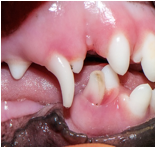
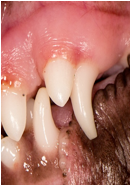
You may also notice a characteristic breath odor, known as 'puppy breath', which is associated with teething. This odor is normal and will last as long as the puppy is teething.
"During the teething
process, your puppy may drool, be reluctant to eat at times, and he may be
irritable
due to a tender mouth. Almost all puppies will have
the urge to chew when they are teething."
What is a retained tooth?
A retained tooth occurs when the tooth root is either incompletely resorbed or it did not resorb at all. When this happens, the baby tooth occupies the place in the mouth that is meant for the permanent tooth, forcing the permanent tooth to erupt at an abnormal angle or in an abnormal position. The end result is often crowding or malposition of the tooth, causing an abnormal bite.
"A
retained tooth is a deciduous or baby tooth that is still present in the mouth
after its replacement
permanent or adult tooth has erupted."
Which deciduous teeth are more commonly retained?
The most common teeth to be retained are the upper canine teeth, followed by the lower canine teeth and the incisors. However, in some cases, the premolar teeth may also be retained.
Retained teeth are more common in small breed dogs, and in dogs that have pushed-in faces such as bulldogs, pugs, Boston terriers, and boxers.
There may also be a genetic predisposition to developing retained primary teeth as it often occurs in families of dogs.
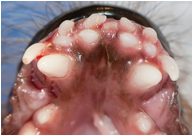
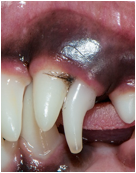
What problems are caused by retained teeth?
If both a deciduous tooth and a permanent tooth are in the same socket in the jaw, the crowding of the two teeth will increase the likelihood that food and debris will become trapped between the teeth. This can lead to problems such as tartar deposits, tooth decay, gingivitis and periodontitis, all of which can lead to premature loss of teeth. If the root of the retained tooth has only been partly resorbed, it can become badly infected.
If teeth are malpositioned, they can rub against other teeth, wearing away the enamel and weakening the tooth. Occasionally, a retained deciduous tooth can cause a dental interlock which may interfere with the normal growth and development of the jaw bones.
If the retained tooth is a lower canine, the permanent lower canine is forced to grow on the inside of the lower jaw and its tip usually grows towards the roof of the mouth, causing pain and damage which makes it difficult for your dog to eat.
"This
can lead to problems such as tartardeposits, tooth decay, gingivitis and
periodontitis,
all of which can lead to premature loss of teeth."
When and how are retained teeth treated?
No two teeth should be in the same socket at the same time. If you notice a retained tooth in your puppy's mouth, make an immediate appointment for an examination. Unless the baby tooth is very mobile, extraction is the treatment of choice. Early extraction in these cases will usually allow the adult teeth to move into their proper positions.
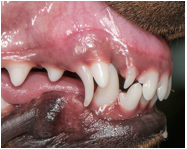 Once a diagnosis and treatment plan is discussed, the
extraction should be scheduled as soon as possible. There is no reason to wait
until your dog gets neutered or spayed. Extraction of the retained tooth will
require a general anesthesia. (Insert Picture 5: Deviated maxillary canine due
to retained deciduous canine tooth)
Once a diagnosis and treatment plan is discussed, the
extraction should be scheduled as soon as possible. There is no reason to wait
until your dog gets neutered or spayed. Extraction of the retained tooth will
require a general anesthesia. (Insert Picture 5: Deviated maxillary canine due
to retained deciduous canine tooth)
Your veterinarian will take special care during the extraction of any retained tooth to avoid damaging the immature roots of the new permanent tooth.
"Early extraction in these cases will usually allow the adult teeth to move into their proper positions."
What happens if there is a delay before the retained tooth is extracted?
If the retained primary tooth is not extracted in a timely manner, it is unlikely that the adult teeth will be able to move into their proper positions without orthodontic treatment. In these cases, or for puppies with severe malocclusion problems, it may be necessary to selectively extract other teeth or to refer your dog to a veterinary dental specialist (www.avdc.org) for orthodontic treatment to reposition the teeth. This treatment often includes the use of orthodontic buttons and elastics.
Is there anything else I should know?
In addition to regular tooth brushing, it is important to check your puppy's mouth every week until about seven to eight months of age to ensure that his teeth are growing normally. If you find any retained teeth, or if you suspect your puppy has an abnormal bite, bring him to your veterinary clinic immediately for an oral examination.